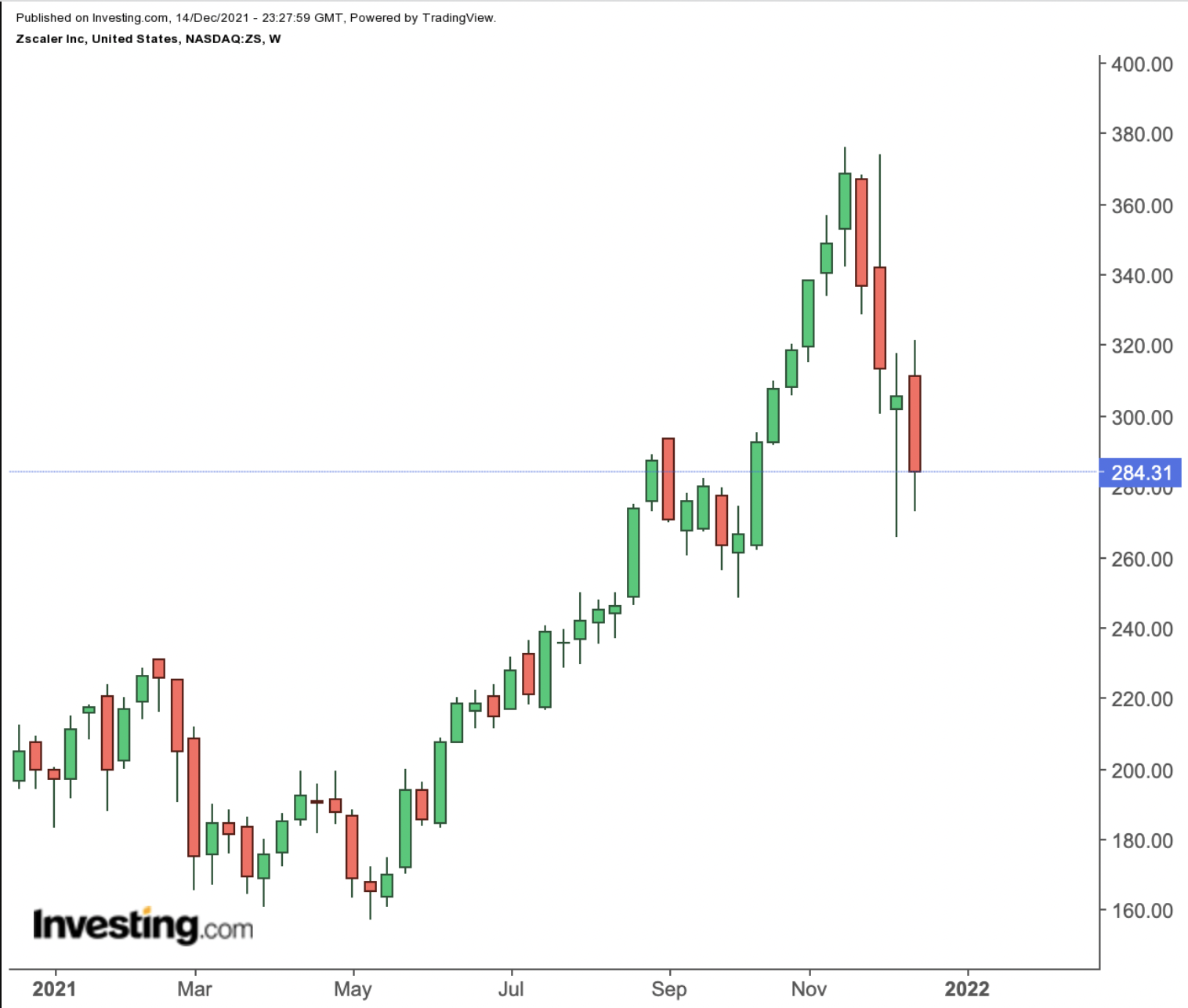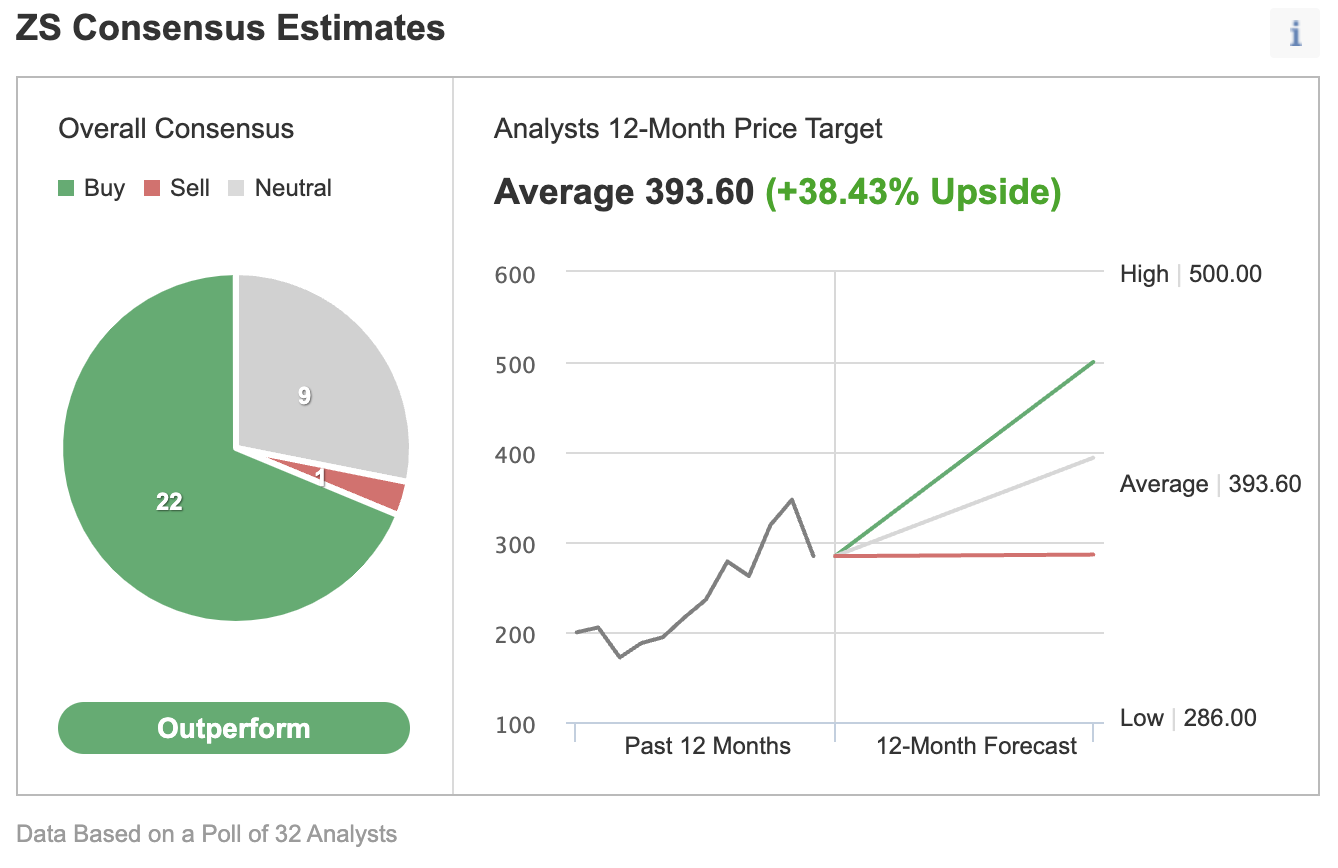Investors in cloud security heavyweight Zscaler (NASDAQ:ZS) have seen strong returns in 2021. Year-to-date, ZS stock has returned 39.3%. By comparison, the First Trust NASDAQ Cybersecurity ETF (NASDAQ:CIBR) is up 11.9%. The weighting of ZS stock in CIBR is 3.35%.

On Nov. 19, ZS shares went over $376 and hit a record high. But since that peak, they are down about 26%, trading around $284. The stock’s 52-week range has been $157.03 - $376.11, and the market capitalization stands at $39.8 billion.
Management issued Q1 2022 financials on Nov. 30. Revenue was $230.5 million, implying a 62% year-over-year growth. Non-GAAP net income per share was flat at 14 cents.
Investors were pleased to see robust top line growth, and management’s Q2 outlook was better than analysts’ estimates. For Q2, ZS anticipates total revenue of $240-242 million versus a consensus estimate of $212.3 million.
CEO Jay Chaudhry said:
“We delivered outstanding results for the first quarter, with year-over-year revenue growth accelerating to 62%. We recently achieved a significant milestone of surpassing $1 billion in annual recurring revenue (ARR), and are now focusing on achieving $5 billion in ARR.”
Prior to the release of the quarterly results, ZS stock was trading around $355. The next day, it saw an intraday high of $373.74. But since then, bears have gotten the upper hand. Then came an analyst downgrade on Dec. 6.
Now, shares are hovering around $284. Readers should note that on Dec. 20, ZS stock will be added to the NASDAQ 100 index.
What To Expect From Zscaler Stock
Among 32 analysts polled via Investing.com, ZS stock has an “outperform" rating.

Chart: Investing.com
Analysts also have a 12-month median price target of $393.60 on the stock, implying an increase of more than 40% from current levels. The 12-month price range currently stands between $286 and $500.
However, according to a number of valuation models, such as those that might consider P/E multiples or the 10-year Discounted Cash Flow (DCF) growth exit method, the average fair value for Zscaler stock stands at $205.33, implying a downside risk of more than 25%.
Moreover, we can look at the company’s financial health determined by ranking more than 100 factors against peers in the information technology sector. In terms of profit health and relative value, Zscaler scores 1 (lowest score) out of 5 (top score). Its overall performance is rated “fair.”
P/B and P/S ratios for ZS stock are 74.6x and 51.9x. By comparison, those metrics for peers stand at 18.9x and 14.5x. Put another way, Zscaler stock has a frothy valuation level.
Finally, readers who watch technical charts might be interested to know that several of ZS stock’s short-term indicators are cautioning investors and suggesting that the recent decline might continue in the coming weeks.
We expect Zscaler stock to potentially drop toward $250 or even slightly below. In that case, the $240 level should act as support.
Following such a potential decline, ZS shares are likely to trade sideways for several weeks, until they establish a base, possibly around $250, and then start a new leg up.
Therefore, Zscaler bulls with a two- to three-year horizon who are not concerned about short-term volatility could consider buying the stock around these levels for long-term portfolios. Others, who are experienced with options strategies and believe there could be further declines in ZS shares, might prefer to do a bear put spread.
Most option strategies are not suitable for most retail investors. Therefore, the following discussion is offered for educational purposes and not as an actual strategy to be followed by the average retail investor.
Bear Put Spread On ZS Stock
Current Price: $284.34
In a bear put spread, a trader has a long put with a higher strike price as well as a short put with a lower strike price. Both legs of the trade have the same underlying stock (i.e., Zscaler) and the same expiration date.
The trader wants ZS stock to decline in price. However, in a bear put spread, both the potential profit and the potential loss levels are limited. Such a bear put spread is established for a net cost (or net debit), which represents the maximum loss.
Let’s look at this example:
For the first leg of this strategy, the trader might buy an at-the-money (ATM) or slightly out-of-the-money (OTM) put option, like the ZS Jan. 21, 2022, 270-strike put option. This option is currently offered at $15.55. It would cost the trader $1,555 to own this put option that expires in slightly less than two months.
For the second leg of this strategy, the trader sells an OTM put, like the ZS Jan. 21, 2022, 260-strike put option. This option’s current premium is $11.85. The option seller would receive $1,185, excluding trading commissions.
Maximum Risk
In our example, the maximum risk will be equal to the cost of the spread plus commissions. Here, the net cost of the spread is $3.70 ($15.55 – $11.85 = $3.70)
As each option contract represents 100 shares of the underlying stock, i.e. ZS, we would need to multiply $3.70 by 100, which gives us $370 as the maximum risk.
The trader could easily lose this amount if the position is held to expiry and both legs expire worthless, i.e., if the Zscaler stock price at expiration is above the strike price of the long put (or $270.00 in our example).
Maximum Profit Potential
In a bear put spread, potential profit is limited to the difference between the two strike prices minus the net cost of the spread plus commissions.
So in our example, the difference between the strike prices is $10 ($270 – $260 = $10). And as we’ve seen above, the net cost of the spread is $3.70.
The maximum profit, therefore, is $6.30 ($10 – $3.70 = $6.30) per share less commissions. When we multiply $6.30 by 100 shares, the maximum profit for this option strategy comes to $630.
The trader will realize this maximum profit if ZS stock price is at or below the strike price of the short put (lower strike) at expiration (or $260 in our example).
Investors who have traded options before are likely to know that short put positions are typically assigned at expiration if the stock price is below the strike price (i.e., $260 here). However, there is also the possibility of early assignment. Therefore, the position would need monitoring up until expiration.
Break-Even ZS Price At Expiration
Finally, we should also calculate the break-even point for this trade. At that price, the trade will not gain or lose any money.
At expiration, the strike price of the long put (i.e., $270 in our example) minus the net premium paid (i.e., $3.70 here) would give us the break-even ZS price.
In our example: $270 − $3.70 = $266.30 (minus commissions).
Bottom Line On Zscaler Shares
We consider Zscaler stock to be a solid long-term cybersecurity choice for most retail portfolios. However, from a fundamental valuation level, ZS shares look expensive.
Also, as we await updates from the Federal Reserve, there could be further volatility and decline in the price. Therefore, a trading strategy as outlined here might be appropriate for traders with a bearish outlook on Zscaler shares.
